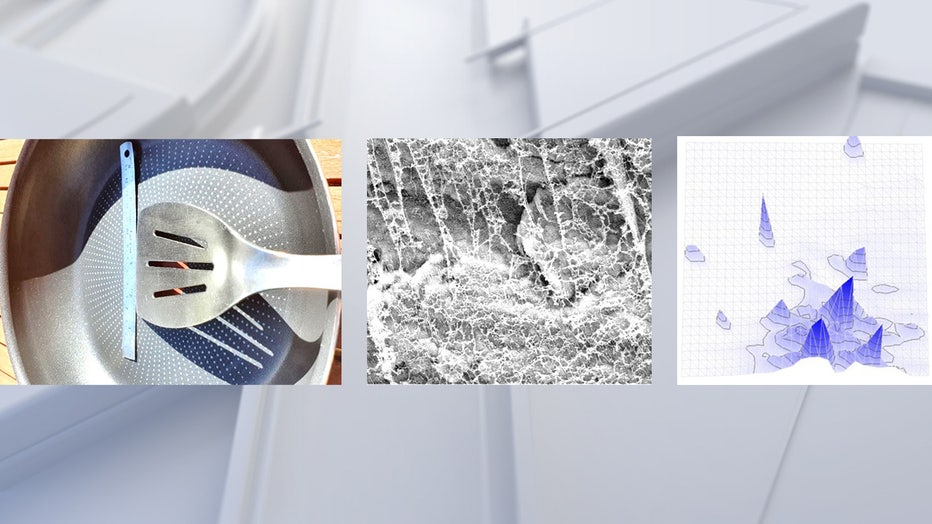Non-stick pans could be releasing millions of tiny plastic particles into your food, study finds
A recent study found that those wonderfully convenient non-stick pans you’ve been using could actually be releasing thousands of microplastics and/or nanoplastics with each use, especially if they’ve been damaged.
Researchers in Australia used a specialized imaging process called Raman on pans coated with Teflon and found that, with each use, it is estimated that thousands, and maybe even millions, of microplastic particles are being released.
Teflon is a synthetic plastic which is chemically composed of carbon and fluorine atoms, according to the study. It has an extremely low level of friction and notable chemical, thermal and electrical stability.
However, Teflon is a member of PFAS, which are also known as "forever chemicals" because they last so long in the environment. They have been associated with serious health conditions, including cancer and reduced birth weight.

FILE - Chef tooks sausage and veggies in a pan. (Marie Ostrosky for The Washington Post via Getty Images)
PFAS is short for per- and polyfluoroalkyl substances that are used in nonstick frying pans, water-repellent sports gear, stain-resistant rugs, firefighting foam and many other products. The chemical bonds are so strong that they don’t degrade or do so only slowly in the environment and remain in a person's bloodstream indefinitely.
"As emerging contaminants, microplastic/nanoplastic is a big concern with lots of unknowns. Teflon is a member of PFAS, so Teflon microplastic/nanoplastics make the concern even bigger," said co-author of the study and senior research fellow at the University of Newcastle Australia, Dr. Cheng Fang.
RELATED: Microplastics found in human blood for the 1st time, study says
What are microplastics and nanoplastics?
Microplastics are pieces of plastic that measure less than 5 millimeters and nanoplastics measure less than 1 micrometer. So in short, they are very small pieces of plastic that are not easily detectable to the naked eye.
Teflon’s teenie tiny plastics

From left to right - Tested cookware with steel spatula (L), a scanning electron microscope (SEM) image (M) and the Raman imaging results detecting particles. (Dr. Cheng Fang)
Fang and his team tested six different non-stick pots and pans — four new and two used — and mimicked a typical cooking or cleaning process. Researchers noted no actual food or cooking oils were used in this experiment and said the process was akin to what they called a "dry run."
A steel spatula, a barbeque clamp, a stainless steel wool scrubber and a wooden spatula were used on the tested cookware.
Researchers estimated about 9,100 particles of microplastics/nanoplastics could be released from small scratches during cooking and a whopping 2.3 million particles could be released from significantly damaged areas such as cracks or fractures.
Fang also noted that even if there was no damage to the cookware, the non-stick coating could still release particles over time as the coating can be worn down with each use.
"It depends but most likely is inevitable from our current test, unfortunately," Fang said about the non-stick cookware releasing particles over time. "You might note that your non-sticking pot/pan gradually (after years of use) becomes yellow and looks no longer brand-new, which is supposedly releasing particles over its lifetime."
These estimates could also be more or less "depending on cooking style/habit, turner/pan materials/approaches etc.," Fang said.
Separately, Americans eat, drink and breathe in an estimated 74,000 and 121,000 microplastics each year, depending on their age and gender, according to a study published in Environmental Science & Technology.
Those who only drink bottled water over tap water can ingest an additional 90,000 plastic particles each year, the study found.
"Individuals who meet their recommended water intake through only bottled sources may be ingesting an additional 90,000 microplastics annually, compared to 4,000 microplastics for those who consume only tap water," the study stated.
RELATED: Infants ingest 15 times more microplastics than adults, new study finds
What’s next?
Further research on better detecting microplastics and nanoplastics is warranted, according to Fang, as well as the long-term health impacts of ingesting such tiny inorganic particles.
"We are actually being surrounded by lots of plastic items in our daily lives. We need and enjoy them. However, most of them can release particles/fragments in their lifetime as microplastics and even nanoplastics. Microplastics/nanoplastics contamination are everywhere," Fang said. "While the risk assessment is not yet done, we should be cautious to avoid the potential contamination in our kitchen and in our food."
Kelly Hayes contributed to this report. This story was reported from Los Angeles.


